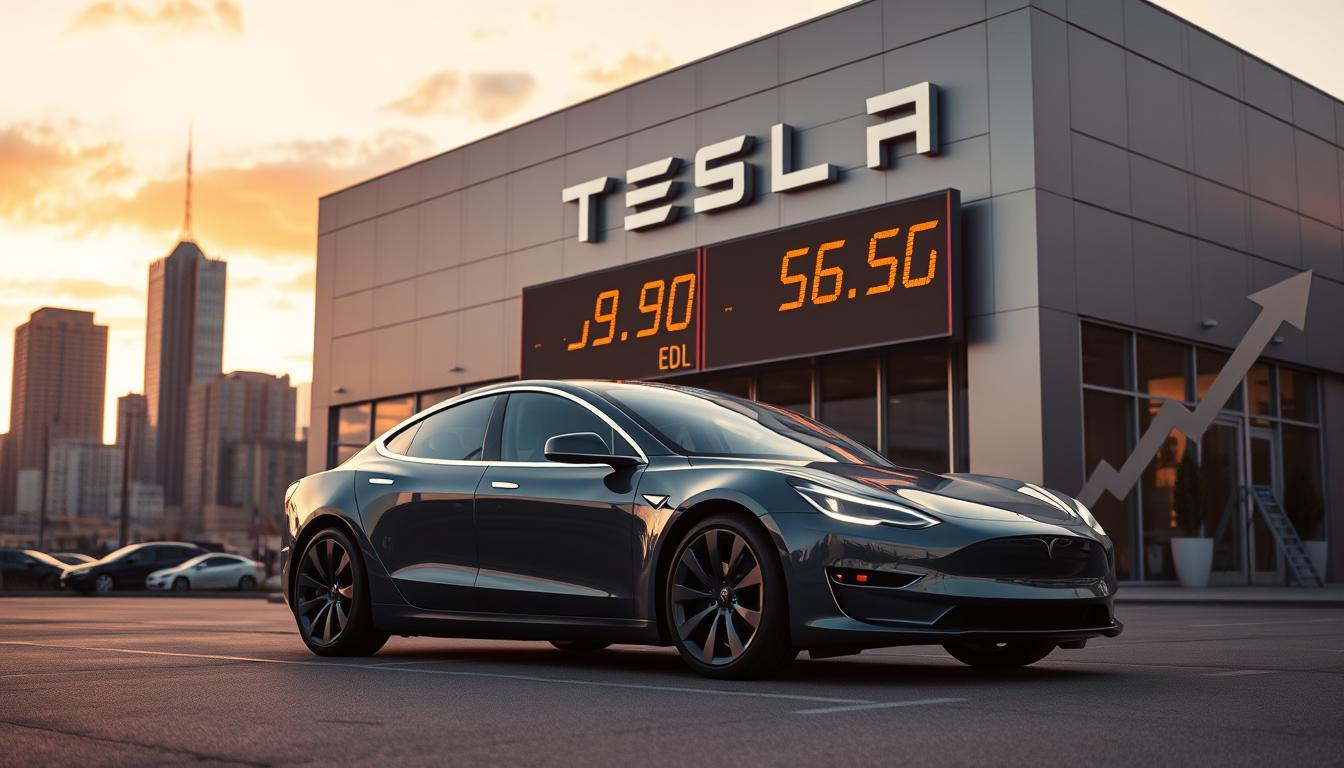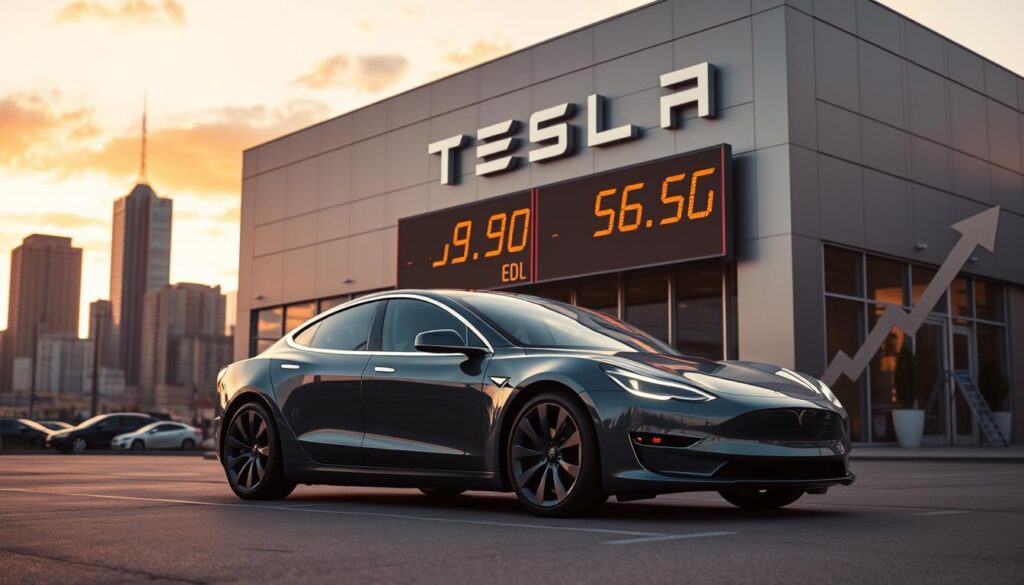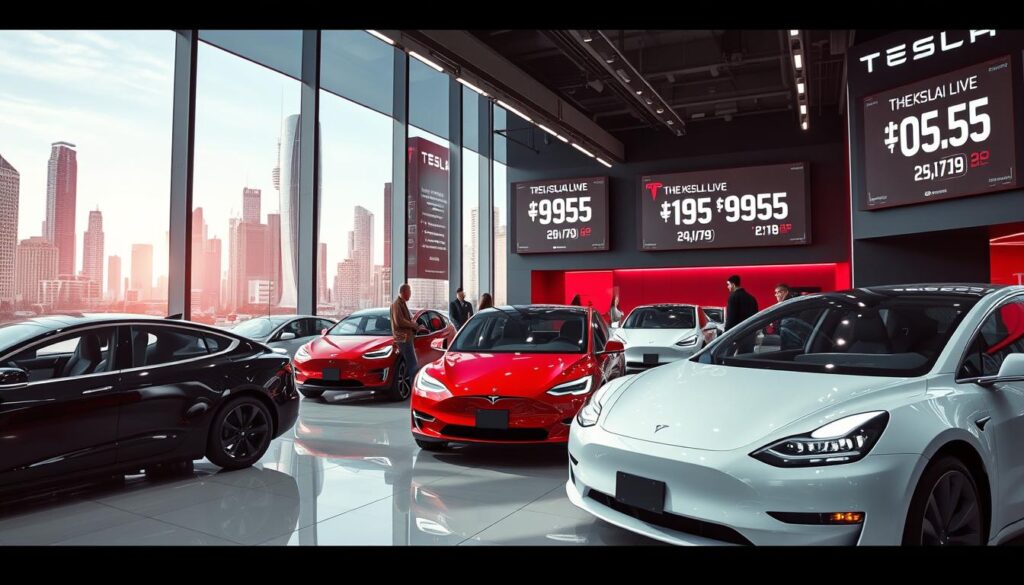

Ever thought about why companies like Tesla change their prices? Recently, Tesla raised its car prices in America, sparking lots of talk. This move shows how Tesla keeps up with the market. It also shows how the electric car world is changing.
The biggest change is in the Model S, which is very popular. This move shows Tesla’s plan to stay ahead in a tough market. It’s important for people thinking about buying Tesla cars to understand why prices went up.
Key Takeaways
- Tesla’s recent price adjustments focus on its high-demand Model S.
- The Tesla price increase reveals how market fluctuations influence pricing strategies.
- Consumer reactions vary, with many questioning the implications of such cost changes.
- Industry experts believe this move could impact Tesla’s market positioning.
- Potential buyers should consider the long-term value of investing in Tesla vehicles despite price hikes.
Understanding Tesla’s Recent Price Increase
Tesla’s price change is due to many factors in the car world. The Model Y’s price in the U.S. went up by $1,000. Now, the rear-wheel drive Model Y costs $43,990, and the long-range version is $48,990.
This price hike is because of higher production costs. Tesla faces inflation and supply chain issues. These problems affect how much it costs to make cars.
Prices for the Model Y Performance and other models stayed the same. But, Tesla had lowered prices on some Model Ys until February 29 to boost sales. Now, people are choosing hybrids more because of higher costs and tax credit changes.
The price increase might also help Tesla make more money. Tesla shares have dropped over 18% in 2024 but have slightly gone up in the last year. This shows Tesla is trying to keep its income steady in a changing market.
It’s important to understand these changes. The electric car world is always changing. This affects both buyers and those who work in the industry.
Details of the Tesla Price Increase
Tesla has made big changes in its pricing strategy. These changes mean higher costs for customers looking to buy different models. We’ll focus on the Model S and compare the base and performance versions to understand Tesla’s pricing.
Model S Pricing Changes
The Tesla Model S has seen a big price jump, up by $5,000. The base All-Wheel Drive (AWD) model now costs $79,990. The high-performance “Plaid” model is $94,990. This change raises questions about how affordable Tesla cars are for buyers.
Comparison of Base and Performance Variants
Looking at the price difference between the two variants helps us see Tesla’s strategy. Here’s a table comparing the specs and prices of both models:
| Variant | Price | Horsepower | 0-60 mph |
|---|---|---|---|
| Model S AWD Base | $79,990 | 670 hp | 3.1 seconds |
| Model S Plaid | $94,990 | 1,020 hp | 1.99 seconds |
In conclusion, Tesla’s price changes aim to strengthen its luxury image. They also cater to those who want high performance. These moves reflect Tesla’s pricing strategies in a changing market and consumer mood.
Tesla Vehicle Cost Hike and Its Implications
The recent Tesla vehicle cost increase has big changes for both current and potential customers. With higher prices, people thinking about buying a Tesla might reconsider. This is because the cost changes a lot, affecting their budget plans. Owners might also think about their car’s resale value as the market changes.
Impact on Customers
Luxury electric vehicle buyers now face a bigger financial challenge. For example, the Model Y high performance vehicle’s price went up from $62,990 to $65,990. The Model 3’s price rose from $54,490 to $57,990. The Model S high performance edition’s price jumped from $99,990 to $104,990, affecting consumer choices.
Even the Model X saw a $6,000 price hike. These changes show a clear shift in market dynamics.
Future Expectations for Tesla Car Pricing
Market analysts are unsure about Tesla’s future pricing. With Tesla’s fourth price increase in the U.S. for 2022, there’s a lot of uncertainty. Delivery delays of up to 12 months for some models add to the worries, making buyers look at other options.
Rivian Automotive has also raised its prices, making the competition even tougher. Tesla’s pricing strategy will likely keep changing with the economy. As buyers try to make sense of these changes, price shifts will play a big role in their decisions.
Tesla Raises the Price of its Cars in America

Tesla has made changes to its car prices in response to market conditions. These changes are part of the company’s strategy to adapt to economic changes.
Reasons Behind the Pricing Strategy
Several factors influence Tesla’s pricing strategy, including:
- Increasing raw material costs affecting production.
- Challenges with shipping and logistics impacting delivery schedules.
- Broader economic indicators, such as inflation, pushing overall prices higher.
- Intensifying competition within the electric vehicle sector, requiring careful balancing of profitability and consumer appeal.
Market Trends Affecting Tesla Costs
Understanding Tesla’s market trends is key to its success. Key factors affecting Tesla’s car prices in the US include:
- The shift toward sustainable energy and electric mobility increasing demand.
- Technological advancements leading to enhanced vehicle features and efficiency.
- Consumer expectations evolving, necessitating a balance between innovation and cost control.
The Tesla automotive market is constantly evolving. This presents both challenges and opportunities for the company as it navigates these trends.
Analysis of Tesla’s Pricing Strategy
Tesla’s pricing strategy has evolved over time, influenced by the growing electric vehicle market. The company has made price adjustments to stay competitive. For example, the Model 3’s price has gone up from $35,000 in 2017 to $46,990 today.
Tesla uses a direct selling model to cut costs. They have high-end stores and online ordering. This approach lets Tesla quickly change prices based on market needs. In 2023, they even cut prices by about 20% to meet high demand and compete with new rivals.
Prices for Tesla’s vehicles have increased across the board. The Model Y’s price dropped from $74,000 to $69,000, showing this trend. Even the Cybertruck’s starting price went up from $39,900 to over $50,000. Tesla aims to balance affordability with profit, staying ahead in the electric vehicle market.
Despite challenges like rising raw material costs and competition, Tesla remains strong. They continue to adjust prices to grow and meet customer needs.
Reactions from the Automotive Market

Recent Tesla price hikes have sparked different views in the car world. Some people are unhappy about the higher costs of Tesla cars. They point out that many other cars, both gas and electric, are getting cheaper.
They think Tesla’s price increase is unfair. This is especially true since other brands like Nissan and Ford are cutting their prices.
Consumer Perspectives on Price Hikes
What people think about Tesla’s price increase varies a lot. Many buyers are upset. They blame the rise in prices on the economy without seeing a clear reason.
They notice that other electric cars are getting cheaper. For example:
- Nissan’s Ariya saw a price reduction of up to $6,000.
- Ford’s Mustang Mach-E was decreased by as much as $8,100.
- Overall electric vehicle prices, like those of the Tesla Model Y, have dropped by 21% recently.
Industry Experts’ Opinions
Industry analysts have different opinions on Tesla’s pricing strategy. Some think the higher prices might make Tesla stand out more. They believe it could help Tesla stay ahead of cheaper rivals.
But others warn that higher prices could scare off buyers who are watching their budgets. With car prices going down overall, Tesla’s increase might be a turn-off.
| Automaker | Vehicle Model | Price Reduction |
|---|---|---|
| Nissan | Ariya | $3,600 – $6,000 |
| Ford | Mustang Mach-E | Up to $8,100 |
| Tesla | Model Y | 21% decrease overall |
Tesla Car Pricing Update: What Buyers Should Know
When Tesla raises prices, buyers need to think about how it affects their choices. The Tesla auto price raise has changed prices for many models. For example, the Model Y rear-wheel drive and long-range now cost $43,990 and $48,990, up by $1,000.
It’s key for buyers to understand the latest Tesla car pricing update. They might need to adjust their budget or look at other models. Earlier this year, prices for the Model S and Model X dropped by $3,500 and $8,500, respectively. But now, prices are going up, so buyers must be careful with their choices.
Looking into incentives and financing options can help with the higher costs. Some Tesla models, like the Model S, have seen big drops in resale value. This is something budget-conscious buyers should consider.
| Model | Previous Price | Current Price | Price Change |
|---|---|---|---|
| Model S | $30,000 less (earlier this year) | Price varies based on options | Decrease of $3,500 |
| Model X | $41,000 less (earlier this year) | Price varies based on options | Decrease of $8,500 |
| Model Y Rear-Wheel Drive | $42,990 | $43,990 | Increase of $1,000 |
| Model Y Long-Range | $47,990 | $48,990 | Increase of $1,000 |
This pricing change is a reminder for buyers to stay informed and strategic. It’s important to consider personal budgets and market changes when making a Tesla purchase.
Conclusion
The recent Tesla pricing update shows a smart strategy to deal with market changes. The prices of Model S and Model X have gone up to $107,490 and $97,490. This change might make some people think twice before buying a Tesla.
Even though the prices of premium models are still lower than before, the increase is noticeable. Tesla’s car sales reached $19.96 billion in the first quarter. This shows the brand’s strength, even when profits went down.
As electric cars become more popular, Tesla’s pricing will play a big role. It’s important for buyers to keep up with price changes. This way, they can make smart choices in a fast-changing market.
FAQ
Why has Tesla increased the prices of its cars in America?
Tesla raised prices due to inflation, higher production costs, and keeping profit margins. This change shows the brand’s adaptability to market shifts.
How much has the price of the Model S changed?
The Model S price went up by $5,000. The base AWD model now costs $79,990. The “Plaid” performance model is $94,990.
What are the implications of Tesla’s price adjustments for consumers?
The price hike might make buyers rethink their budgets. It could affect resale values and what buyers choose to buy. People might look at other Tesla models now.
How might competitors respond to Tesla’s pricing strategy?
Other car makers might change their prices or offer more value to stay competitive. This is key for Tesla’s market share and appeal to budget-conscious buyers.
What should potential buyers know about Tesla’s new pricing structure?
Future buyers should know the new prices and look into incentives and financing. This knowledge helps them make informed choices in the changing market.
What factors are influencing Tesla’s pricing strategy?
Tesla’s pricing is shaped by rising material costs, supply chain issues, electric car competition, and economic factors like inflation.
What reactions have consumers had regarding the price increase?
Opinions are split, with some unhappy about the higher prices and others seeing the economic reasons. This shows a range of feelings about Tesla’s price changes.
Are there expectations for future price changes from Tesla?
Experts think Tesla’s prices might keep changing as the car market evolves. This will be influenced by ongoing market trends, production costs, and demand.






